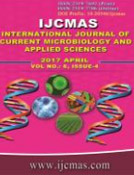


 National Academy of Agricultural Sciences (NAAS)
National Academy of Agricultural Sciences (NAAS)

|
PRINT ISSN : 2319-7692
Online ISSN : 2319-7706 Issues : 12 per year Publisher : Excellent Publishers Email : editorijcmas@gmail.com / submit@ijcmas.com Editor-in-chief: Dr.M.Prakash Index Copernicus ICV 2018: 95.39 NAAS RATING 2020: 5.38 |
The brewing industry is one of the largest users of water. Even though substantial technological improvements have been made in the past, it has been documented that approximately 3 to 10 litres of wastewater is generated per litre of beer. Field experiments was conducted at United Breweries (UB) Ltd., Nelamangala and Zonal Agricultural Research Station, UAS, GKVK, Bengaluru in sandy loam soil results revealed that application of 150% RDN through TBWW as 50% basal and 50% in three irrigations recorded significantly higher grain yield (39.6 q ha-1) and stover yield (69.9 q ha-1) of maize compared to all other treatments. The maximum total nitrogen, phosphorus and potassium uptake (157.5, 40.7 and 151.9 kg ha-1, respectively) was recorded in 150% recommended N through TBWW as 50% basal and 50% in three irrigations (T8). Similarly same treatment recorded higher fungi, bacterial and actinomycetes (52.19 cfu x105, 31.19 cfu x104 and 19.58 cfu x103, respectively). Increasing brewery wastewater application resulted increasing the quantities of microbial population.
 |
 |
 |
 |
 |